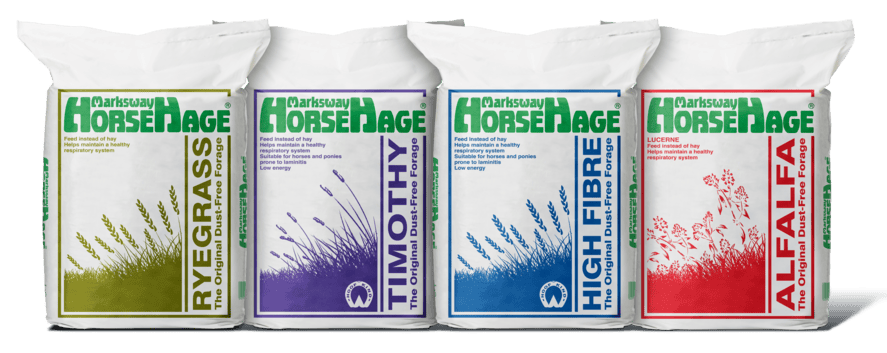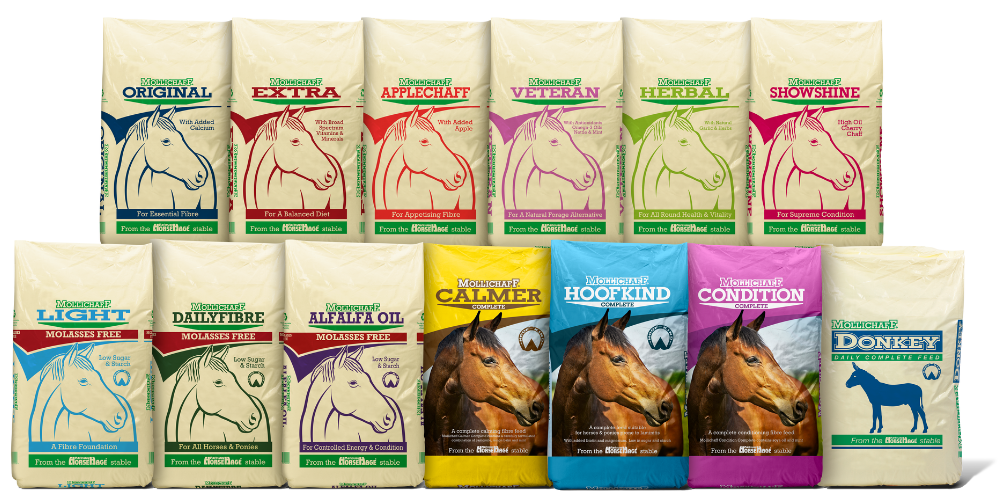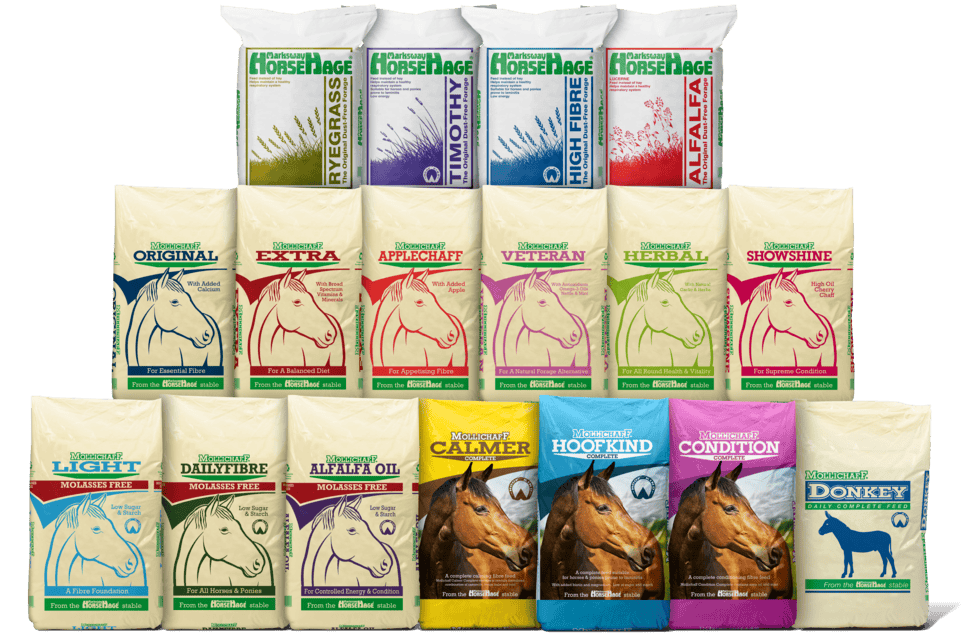Food is moved along the horse digestive tract by muscular contractions or waves known as peristalsis. The gut is designed to receive a small but regular and frequent supply of food (trickle feeding) to encourage these ‘waves’ to continue. A period of as little as eight hours without food may cause a slowing of these muscular contractions and impair the digestive process.
Digestive System of the Horse (Equine Digestive System)
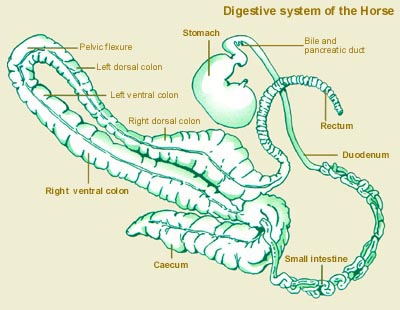
The Mouth or Buccal Cavity
The horse digestive system starts in the mouth. The horse has very sensitive and mobile lips and together with the tongue and front teeth, are used to locate and cut the herbage and bring it into the mouth. The horse has ‘open rooted’ teeth which grow continuously reflecting the effects of the constant grinding of foodstuffs containing high levels of silicon compounds. The modern horse is fed a higher proportion of ‘softer’ feeds such as cereals (despite the fact that cereals or concentrate feed is often referred to as ‘hard’ feed!). Hours spent chewing are restricted and the use of haynets changes the way the horse ‘grinds’ its feed and thus his teeth do not wear evenly. The modern horse’s teeth need regular rasping – at least once a year – in order to ensure that sharp edges are removed, which would otherwise impair the chewing function, and cause bitting problems. The horse must chew all feed in order to:
- Break the food into smaller particles which can be swallowed.
- Disrupt the hard outer covering – cellulose – of plant cells, releasing the starches, proteins and other nutrients contained within.
- Add saliva for lubrication and to reduce it to a semi-liquid pulp. There is a very small amount of enzymic digestion in the mouth. (Unlike humans and dogs, horses do not salivate in anticipation of food, but produce saliva in response to the presence of food in the mouth).
The Stomach
The presence of food in the stomach stimulates the secretion of digestive enzymes and strong acids. Protein and fat digestion begin in the stomach. Under normal circumstances food will start to exit the stomach after approximately 45 minutes.
The Small Intestine
In a typical 16 hands high horse the small intestine will be approximately 21.5m (70 feet long). Digestion continues and absorption of nutrients into the bloodstream begins.
- Starch and sugar digestion is mainly completed (as long as the quantity fed does not exceed the capacity of the small intestine) and the end products – mainly glucose – are absorbed.
- The end products of protein digestion – amino acids – are absorbed.
- Fats and oils are ‘emulsified’ and broken down into small droplets, aided by the addition of bile from the liver (the horse has no gall bladder to store bile – it is produced as required).
- Mineral and vitamin absorption begins.
The Large Intestine
This part of the equine digestive system consists of the caecum, the large colon, the small colon and rectum. The large intestine houses millions of beneficial micro-organisms (including bacteria, yeasts and protozoa) which are the only organisms capable of producing the enzymes necessary to digest cellulose and other components of fibre. The types and proportions of these micro-organisms are dependent upon the diet composition. It is therefore extremely important that all changes to the diet are made very slowly in order to allow the microbial population time to adapt (7-10 days is a sensible practical time over which to introduce new feeds) Rapid dietary changes – such as an influx of water soluble carbohydrates from, for example Spring grass, which passes too quickly through the small intestine – cause major disruptions to the gut microflora, and can lead to metabolic disturbances ranging from laminitis to filled legs.
The normal end products of microbial digestion (from digestible fibre or starches and sugar) are volatile fatty acids, which enter the bloodstream and are ultimately broken down at a cellular level to produce energy. If the horse is fit and healthy and provided with good quality, mould-free forage, the microflora in the hindgut manufacture some of the B Complex vitamins and Vitamin K. Performance horses under stress or horses fed poor quality or mouldy forage, or foals with an undeveloped microbial population, will not perform this function adequately and will need an additional dietary supply of these vitamins.
Water resorption occurs in the large intestine and mineral and vitamin absorption continues. Metabolic wastes from all other parts of the body are transported via the bloodstream to the rectum. The waste products together with undigested material are formed into faeces and voided via the anus.
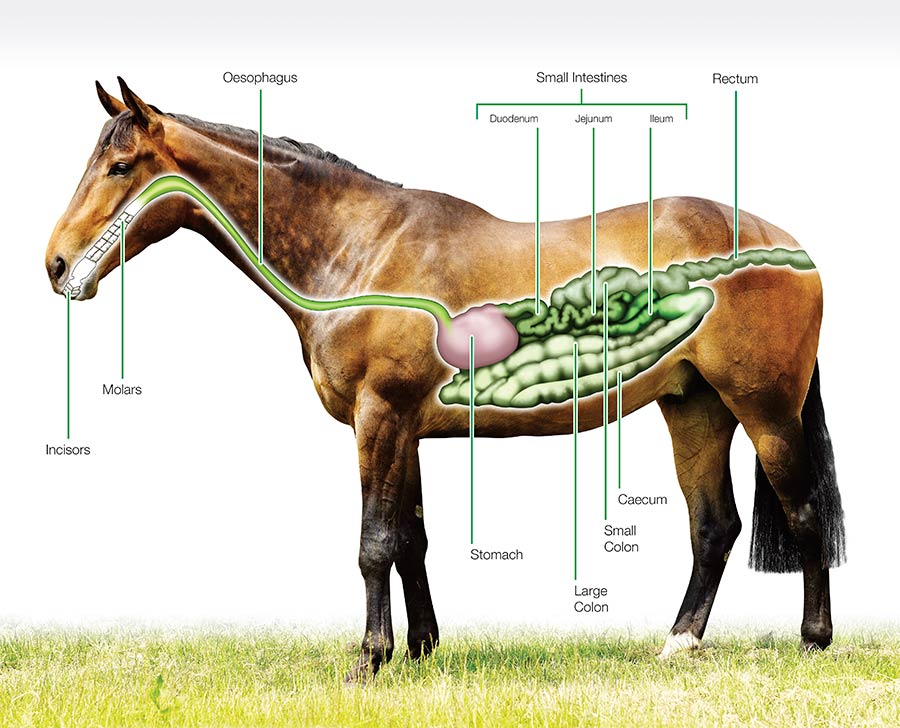
Important Notes
- The stomach capacity of the horse is between eight and 15 litres, depending on the size of the horse. Optimum digestion occurs when the stomach is not more than two thirds full. For the average 16 hands high horse weighing approximately 500kg it has been calculated that a feed of 4.5 lbs (2kg) will fill approximately two thirds of the stomach. The stomach phase of digestion is less important in the horse who receives a high fibre diet because fibre is mainly digested in the hind gut. However, in the horse fed a high proportion of concentrates, the stomach plays a more significant role in digestion.
- If food continues to enter the stomach once it is full, the pyloric sphincter will open to allow feed to enter the small intestine. This is the normal function for the roughage fed horse. In the horse fed a high level of concentrates this trickle mechanism does not allow the food to stay sufficiently long in the stomach for efficient digestion to occur.
- If intake is very great and rapid, the trickle mechanism is not activated and the stomach swells to beyond capacity. This distension switches off stomach function by inhibiting normal blood flow and neural activity. Fermentation of the stomach contents then occurs and gases are produced which further distends the stomach. This malfunctioning can lead to disorders ranging from mild colics to stomach rupture and death.
Horse Digestive System Management Suggestions
Horses with regular digestive system problems should be looking for high quality, expertly made horse feeds. At Horsehage & Mollichaff we do our utmost to craft horse feeds and forage that suits all dietary requirements or restrictions, so why not give us a call? We would be happy to speak to you to understand your horse’s requirements and we can even recommend your nearest supplier using our stockist locator.
HorseHage Range
Our HorseHage range comes in four different varieties offering different energy values, allowing you to choose the variety most suitable for your horse.
View RangeMollichaff Range
From high quality chaffs to complete feeds, our Mollichaff range offers a number of different options individually tailoring the feed to your horses needs.
View Range
